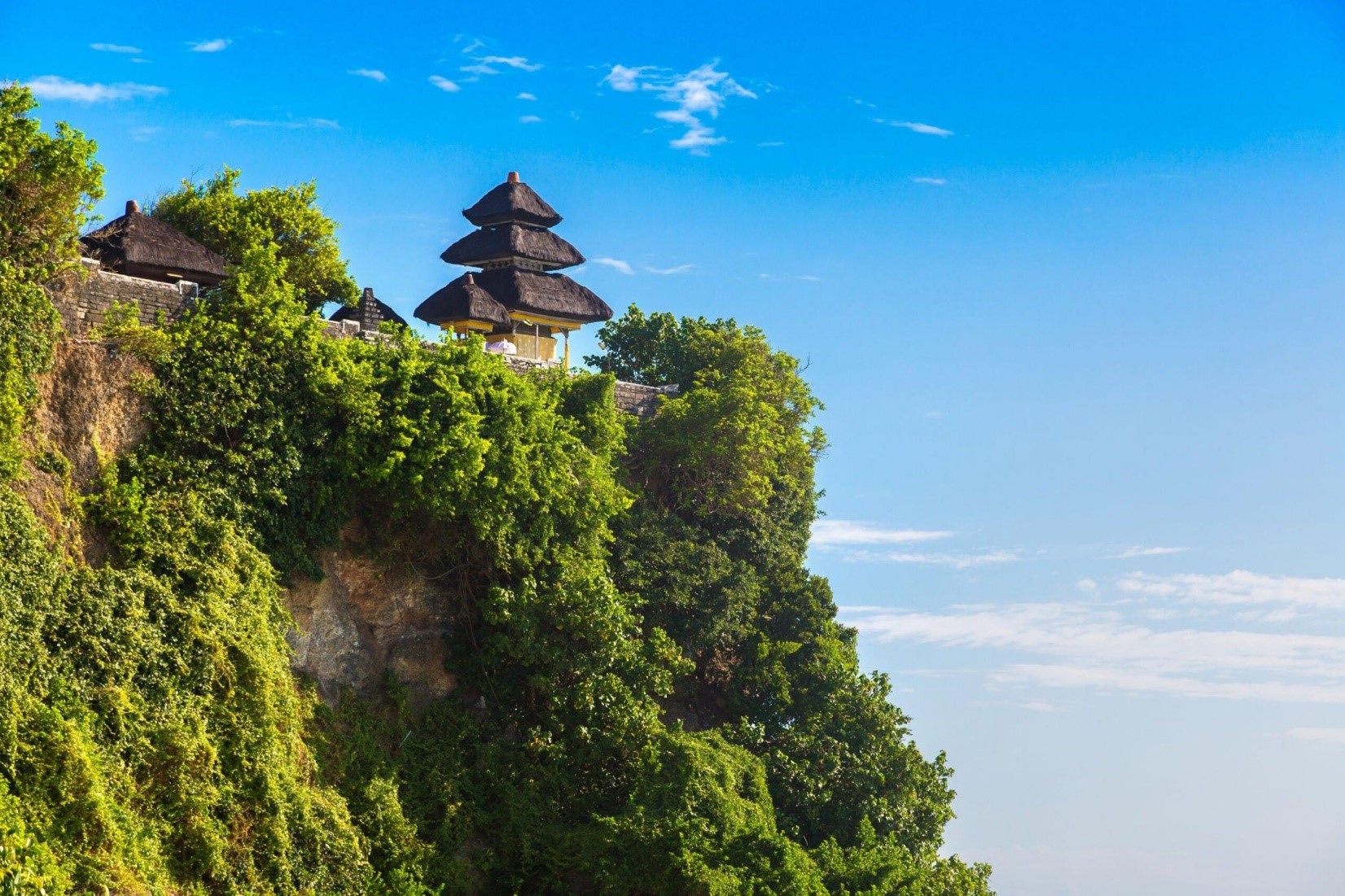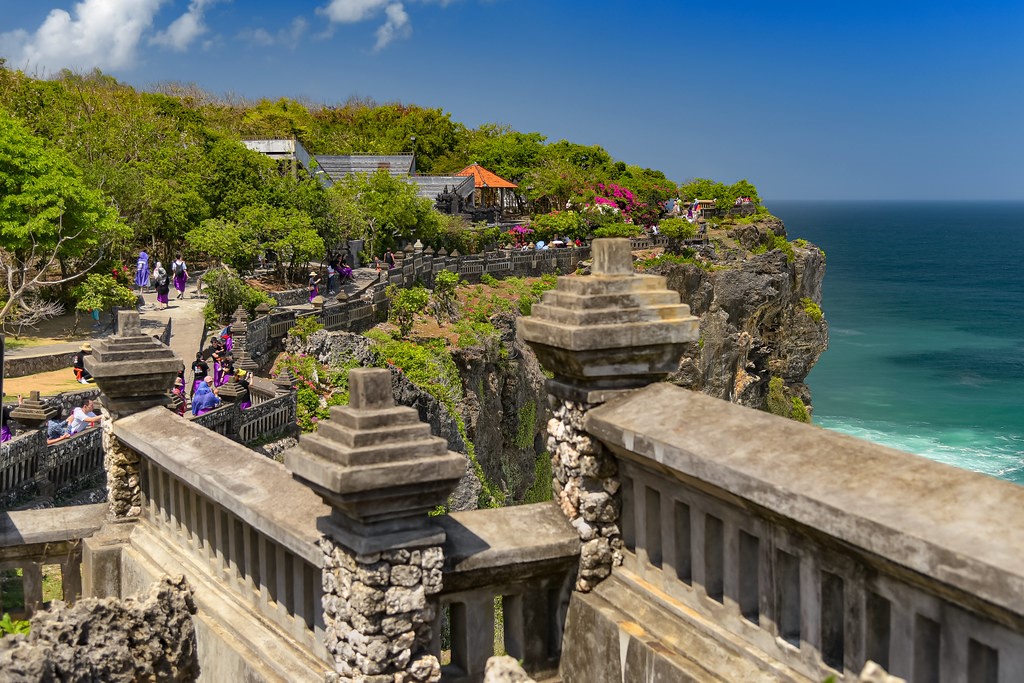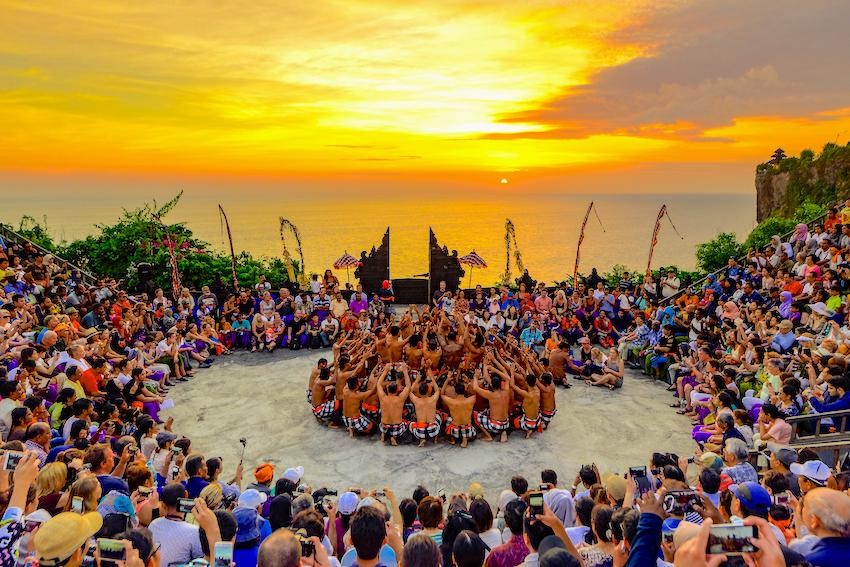Khám Phá Đền Uluwatu - Biểu Tượng Văn Hóa Linh Thiêng của Bali
Một trong những ngôi đền quan trọng nhất ở Bali, Đền Uluwatu, còn được biết đến với tên gọi Pura Luhur Uluwatu, là điểm đến không thể bỏ qua nếu bạn muốn tìm hiểu sâu hơn về văn hóa độc đáo của hòn đảo thiên đường này. Được coi là một trong những “trụ cột tinh thần” của Bali, ngôi đền này không chỉ mang giá trị lịch sử mà còn nổi bật với khung cảnh thiên nhiên tuyệt đẹp, đặc biệt là vào lúc hoàng hôn.
Nguồn Gốc Linh Thiêng của Tên Gọi Uluwatu
Tên gọi “Uluwatu” xuất phát từ tiếng Bali cổ, trong đó “Luhur” có nghĩa là “thứ có nguồn gốc thần thánh”, “ulu” có nghĩa là “tận cùng của vùng đất” và “watu” có nghĩa là “tảng đá”. Tên gọi này đã mô tả một cách khéo léo vị trí độc đáo của ngôi đền: nằm trên một mỏm đá cao chót vót vươn ra biển. Đây là một trong sáu ngôi đền quan trọng của Bali, đóng vai trò như những “trụ cột tinh thần” bảo vệ hòn đảo.

Vị Trí và Cách Di Chuyển Đến Đền Uluwatu
Đền Uluwatu tọa lạc tại làng Pecatu, quận Kuta Nam, Badung, Bali. Ngôi đền nằm trên đỉnh của một vách đá dựng đứng cao khoảng 70 mét so với mặt biển, tạo nên một khung cảnh hùng vĩ và thơ mộng. Để đến được đây, bạn có thể mất khoảng một giờ đi xe từ khu vực Kuta hoặc sân bay Denpasar.
Phương tiện giao thông công cộng không đến được đền Uluwatu, do đó cách tốt nhất để tham quan là thuê xe có tài xế hoặc tham gia các tour du lịch có hướng dẫn. Một trong những gợi ý phổ biến là tour kết hợp tham quan Đền Uluwatu, thưởng thức màn biểu diễn múa Kecak và dùng bữa tối lãng mạn tại Bãi biển Jimbaran.
Lịch Sử Hình Thành Đền Uluwatu
Lịch sử của Đền Uluwatu bắt đầu từ thế kỷ thứ 11 khi nhà sư Majapahit, Mpu Kuturan, khởi xướng việc xây dựng ngôi đền. Ngôi đền sau đó được mở rộng đáng kể bởi một nhà hiền triết từ Java, Empu Kuturan. Theo truyền thuyết, nhà linh mục Dhang Hyang Dwijendra (còn gọi là Danghyang Nirartha) đã chọn Đền Uluwatu làm điểm cuối trong hành trình tâm linh của mình. Đền thờ Siva Rudra, vị thần của tất cả các yếu tố và khía cạnh của cuộc sống trong vũ trụ theo đạo Hindu.

Trải Nghiệm Hành Hương Tại Đền Uluwatu
Một chuyến tham quan Đền Uluwatu sẽ mang lại cho bạn nhiều trải nghiệm thú vị và độc đáo. Khi đi qua khu rừng nhỏ quanh đền, bạn sẽ thấy rất nhiều khỉ bản địa. Những chú khỉ này được cho là bảo vệ ngôi đền khỏi những ảnh hưởng xấu, nhưng bạn nên cẩn thận với đồ đạc cá nhân vì chúng có thể lấy trộm nếu có cơ hội.
Con đường ngoằn ngoèo dẫn đến đền được củng cố bằng những bức tường bê tông và kéo dài khoảng một giờ đi bộ, nhưng thời gian sẽ trôi qua nhanh chóng khi bạn thưởng thức khung cảnh tuyệt đẹp của đại dương và chụp những bức ảnh ấn tượng. Khuôn viên đền cũng là nơi lý tưởng để tận hưởng không khí trong lành và yên bình.
Kiến Trúc Đền Uluwatu
Đền Uluwatu nổi bật với kiến trúc Bali truyền thống và các tác phẩm điêu khắc cổ xưa. Có hai lối vào lớn và cổ kính đến ngôi đền, một từ phía nam và một từ phía bắc, được bảo vệ bởi các bức tượng của thần voi Ganesha. Đằng sau ngôi đền chính là bức tượng của vị linh mục sáng lập, Dwijendra, cùng với một ngôi đền có hình dạng giống như chiếc thuyền.

Một trong những điểm nhấn của kiến trúc đền Uluwatu là cánh cổng bằng đá có cánh một mảnh dẫn đến sân trong của ngôi đền. Cổng này là một di tích từ thế kỷ thứ 10 và rất hiếm thấy trên đảo. Ngoài ra, ngôi đền còn có các tác phẩm chạm khắc bằng đá được bảo quản tốt, trang trí với các hoa văn tinh xảo.
Thời Điểm Thích Hợp Để Tham Quan Đền Uluwatu
Thời điểm lý tưởng nhất để tham quan Đền Uluwatu là vào buổi chiều, đặc biệt là vào lúc hoàng hôn. Từ tháng 3 đến tháng 9 là khoảng thời gian tốt nhất để ngắm hoàng hôn trong vắt trên Uluwatu. Ngôi đền mở cửa từ 8:00 sáng đến 7:00 tối, và chương trình múa Kecak bắt đầu lúc 6:00 chiều hàng ngày. Đây là một trong những hoạt động không thể bỏ lỡ khi đến Uluwatu.
Trải Nghiệm Văn Hóa Độc Đáo
Một trong những điểm thu hút du khách tại Đền Uluwatu là màn biểu diễn múa Kecak truyền thống của người Bali. Chương trình này diễn ra tại sân khấu mở trên đỉnh vách đá, với bối cảnh hoàng hôn tuyệt đẹp. Điệu múa Kecak, với tiếng hô “chak” đều đặn và nhịp điệu sôi động, mang đến cho du khách cái nhìn thoáng qua về nghệ thuật trình diễn độc đáo của Bali.

Một Số Lưu Ý Khi Tham Quan Đền Uluwatu
- Trang phục: Cả nam và nữ đều cần mặc xà rông và khăn quàng cổ hoặc thắt lưng buộc quanh eo. Bạn có thể mượn xà rông và khăn thắt lưng miễn phí tại ngôi đền.
- Bảo vệ đồ cá nhân: Hãy cẩn thận với các chú khỉ và giữ đồ đạc có giá trị trong túi kín.
- Tôn trọng phong tục: Không chụp ảnh trực tiếp trước mặt những người thờ cúng và cẩn thận không giẫm lên đồ cúng.
Kết Luận
Đền Uluwatu không chỉ là một địa điểm du lịch nổi tiếng mà còn là một biểu tượng văn hóa linh thiêng của Bali. Với kiến trúc độc đáo, cảnh quan thiên nhiên tuyệt đẹp và những trải nghiệm văn hóa phong phú, đền Uluwatu chắc chắn sẽ để lại trong lòng bạn những ấn tượng khó phai. Hãy lên kế hoạch cho chuyến đi của bạn và khám phá vẻ đẹp kỳ diệu của ngôi đền này cùng AVS nhé!


